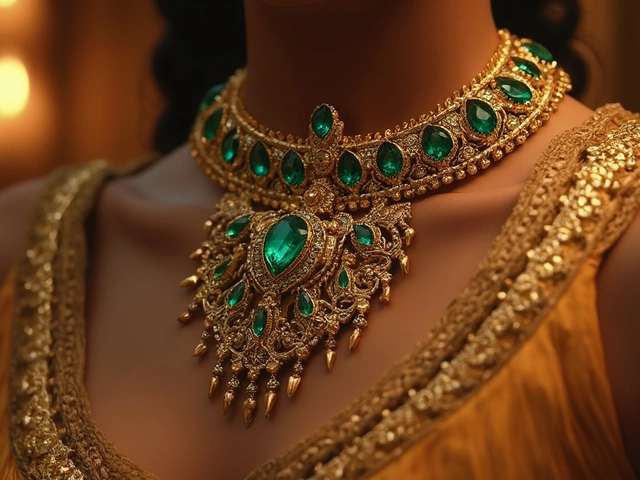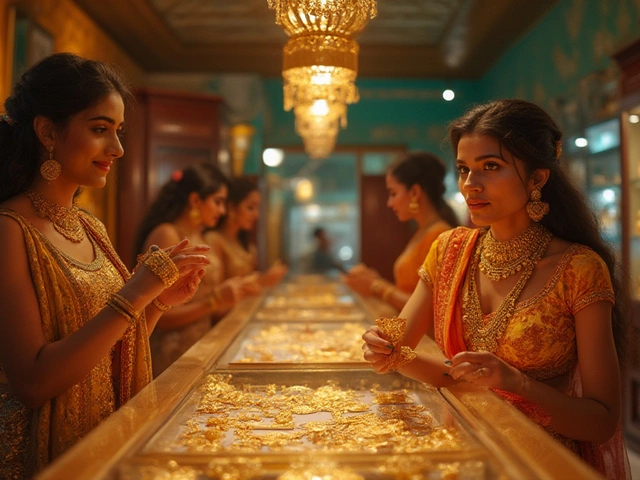Ever thought about making jewelry out of your spare change? Sounds cool, right? But before you get those tools out, you gotta wonder, is it actually legal?
See, currency is usually protected by laws—most governments don’t want folks defacing or altering their money. It's not just about ruining money; it's about keeping financial systems stable. In some places, messing with money can get you into legal hot water.
So, if you've got an itch to craft necklaces from nickels, or bracelets from banknotes, first, you need to check the rules where you live. You’d be surprised how different the laws can be from one country to another.
- The Legal Side of Transforming Money
- Currency Regulations Around the World
- Creative Stories of Money Jewelry
- Tips for Crafting with Coins Legally
- Alternatives to Using Real Money
- Embracing Creativity Within Legal Boundaries
The Legal Side of Transforming Money
So, you're curious about turning your spare change into shiny jewelry? Well, before you go doing that, there are some legal hoops you need to be aware of. Currency isn’t just paper or metal—it’s government property, at least when it comes to the law.
In the United States, for example, there’s the U.S. Code Title 18, Section 333. It’s all about mutilating coins or banknotes. If you do it with intention to defraud, you're in trouble. Over in the UK, it's generally frowned upon to deface coins, but less strict when it comes to paper notes.
How about India? Indian laws regarding currency aren’t as severe, but converting paper notes into wearable art can still spark concern. You’re typically fine if you’re not making money by defacing it.
Now, in some countries, creating coin jewelry can be seen as a cultural craft. In Canada, folks often make jewelry from old coins, but they stay away from active ones in circulation to avoid any issues.
Europe is a mixed bag, where the law can vary from one country to another. So, if you're traveling or buying jewelry making kits online, always check local regulations first.
Here’s a quick tip: while crafting, keep a record of where you sourced your coins or notes. If they’re old and out of circulation, you usually have more wiggle room.
In short, creativity is cool, but dodging fines or awkward legal chats is cooler. Always check the rules, respect the laws, and craft away with peace of mind!
Currency Regulations Around the World
When it comes to making jewelry out of money, rules can be all over the place, depending on where you are. Every country has its own take on what's okay and what's not, so it's super important to know what's up before you get crafting. Let's break it down a bit.
In the United States, the U.S. Bureau of Engraving and Printing states that it's illegal to mutilate or deface currency if you're doing it with the intent to make it unfit for reissue. However, this rule isn't as strict when it comes to coins. Many people get creative with coins because the law is a bit more relaxed about those. Just don't expect to take a hammer to your dollar bills without raising eyebrows.
Over in the UK, things are different. The Currency and Bank Notes Act of 1928 says you can't destroy or deface banknotes, but like the U.S., there's more leeway when it comes to coins. Coins are often used for fun projects or keepsakes, so crafting jewelry with them is actually not too uncommon there.
In India, the Coinage Act of 1906 makes it clear: altering coins or notes can land you in some serious trouble. So, making jewelry out of rupees—whatever the material—probably isn’t the best idea if you value your freedom.
Important SEO Note: While crafting with real currency, always think twice about the laws involved. This consideration is crucial for anyone interested in getting creative with jewelry making.
To wrap it up, here's a quick look at different approaches:
- USA: Tread carefully with notes; coins are more forgiving.
- UK: Banknotes are off the table, coins much less so.
- India: Better keep all currency intact if you don’t want to face legal issues.
It's kind of wild how different places have such different rules, right? Wherever you are, make sure you get your facts straight before diving into this unique craft.
Creative Stories of Money Jewelry
Turning bills and coins into bling isn't just a quirky idea; it's got some seriously cool stories behind it. Back in the 1970s, a jewelry designer named Winston Elkins made waves by crafting an entire collection using coins. He was part of a movement that saw artists and designers turning regular currency into statement pieces, challenging both norms and fashion.
One famous example involves a 1913 Liberty Head nickel, one of the rarest and most desirable coins. Though not originally intended for jewelry, a clever collector decided to embed it into a pendant, transforming it from a simple coin into a prized piece of jewelry that mixed monetary and aesthetic value.
In Thailand, there's a centuries-old practice where the local craftsmen use old coins to create amulets. These are believed to bring luck and fortune to the wearer, merging cultural beliefs with jewelry making. It's a fascinating blend of tradition and artistry.
Even in modern times, people have taken cues from these creative predecessors. Brands have begun to experiment with using old, uncirculated coins, which are no longer legal tender, to craft bespoke jewelry pieces that attract collectors worldwide.
The rise of Etsy has also supercharged this trend. Indie designers are selling necklaces and bracelets made from coins all over the world, proving that the appeal of crafting with money isn’t limited to just big-name designers.
And here's a fun fact—an artist in the US went viral for showcasing a dress made entirely of pennies. Although not precisely jewelry, it highlighted the incredible potential coins have as a medium for creating wearable art.

Tips for Crafting with Coins Legally
Thinking of creating jewelry from coins? It's a fun and unique idea, but keeping it legal is crucial to avoid any trouble. Here's what you should know to keep your coin crafting legit.
First up, research the currency regulations in your area. Many countries have strict laws about defacing or altering money, and penalties can range from a simple warning to hefty fines. Check with your local finance or legal websites to get the lowdown on specific rules.
In the US, for example, it's actually legal to alter coins for artistic purposes, but only if it’s done in a way that doesn't intend to use the altered coin as currency again. On the flip side, altering banknotes is a big no-no.
Here's a quick checklist for crafting with coins safely:
- Research laws: Before you start, check the legal requirements in your country or region.
- Choose the right currency: Consider using old or foreign coins that are no longer in circulation, as they're usually safer to alter.
- Stick to coins: Avoid using banknotes, as they tend to have stricter rules.
- Keep it for fun: Make sure your creations are for personal enjoyment or gifts, not for ensuring monetary exchange.
Another clever hack is to use replica coins designed precisely for crafting purposes. These are made with similar materials but aren't actual currency, making them a safe alternative.
Following these tips, you can transform coins into creative jewelry while staying on the right side of the law. Always balance your love for creativity with respect for legal boundaries. Happy crafting!
Alternatives to Using Real Money
So, you’re itching to make some jewelry without having to worry about breaking any legality rules? There are some pretty neat alternatives to using actual coins or paper bills that keep your craft legal and just as stunning.
First off, consider using replica coins or play money. They're specially made for decorative purposes. You can find these replicas in all sorts of designs and metals, allowing your creativity to shine without risking any fines.
If you're into that vintage vibe, antique stores or online marketplaces like Etsy often have old coins that are no longer in circulation. These can be perfect for crafting unique jewelry pieces. Just double-check their collectible value before snipping them!
Another fun option is to incorporate images or scans of currency into your designs. Print them onto transfer paper and apply them to your jewelry items. This way, you can have the currency aesthetic without touching the real deal.
Also, check out currency-like charms. Many craft stores sell charms that mimic currency symbols or the look of actual coins. They come in various materials from metals to plastics.
- Replica coins
- Out-of-circulation coins
- Printed images on transfer papers
- Currency-themed charms
For those who like to add a little shine, consider mixing metallic beads with your currency-themed elements. It gives you the bling without worrying about the legality concerns of using real cash.
Embracing Creativity Within Legal Boundaries
Alright, you've got the crafting itch, and you're keen on making some unique jewelry pieces while steering clear of legal headaches. First things first, learn the rules regarding using currency in your area. In the US, for example, it's illegal to destroy coins, but making jewelry out of them falls into a gray area and often goes unnoticed if done in small quantities. Just be cautious and maybe don't melt them in bulk.
Got your heart set on using dollar bills? Well, try not to damage them beyond recognition. A quirky pair of earrings from folded notes doesn't usually bother anyone, as long as it's not too extreme. Plus, who doesn’t love a piece that can double as a conversation starter?
Dreaming big? Explore alternatives that keep your conscience and record squeaky clean. Consider replica or novelty money, which can look just as stunning without the legal hang-ups. These materials are also usually cheaper and easier to source, leaving you more room to play with design.
If you're after coins for their metallic charm, why not use discarded coins that have been decommissioned? These have no legal value, so transforming them into art is totally fair game. It's a great way to keep your creativity unrestricted and stay on the right side of the law.
For the rebels at heart, check out international coins or currencies that might be less strict in regulations. Some world currencies are out of circulation and are sold specifically for artistic purposes. Just make sure to do a quick check on their legal status before you start hammering away.
So go ahead, channel that creativity. Whether you choose official currency or replicas, the key is to stay informed and smart about the materials you use. Happy crafting!


